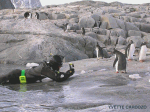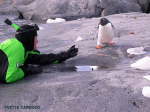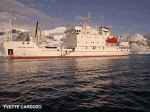by Yvette Cardozo with photography by Yvette Cardozo and Elaine Field
Sep 2003, Vol. 7 No. 12
 Antarctica …. the holy grail of cold water diving. One of the world’s ultimate destinations, this place of explorer’s dreams is as close to serious adventure most of us will ever experience.
Antarctica …. the holy grail of cold water diving. One of the world’s ultimate destinations, this place of explorer’s dreams is as close to serious adventure most of us will ever experience.
Next to a house-size iceberg, swimming in 30 degree water, the Antarctic can be the goal of every diver. Planning this adventure put me in a state of anxiety; excited yet terrified of icebergs, frigid water and the weight of the tremendous amount of gear required for cold water diving. And now, finally, I was here.
The month was late February, almost the end of the austral summer. The routine check out dive was a semi disaster. “Remember the cold makes us all appear stupid,” said dive leader Goran Ehlme, who explained that sea water can actually remain liquid down to 28 degrees. “It might take two days to sort out the dive routine.”
 And, indeed, people dropped weight belts, lost fins; one guy dumped his tank atop his mask, smashing it to shards. Visibility was so poor that buddies had to hold hands. This certainly was not diving for novices. It involved familiarity with drysuits and experience diving in extremely cold water. While there was some technical ice diving, we dove alongside ice, not under it.
And, indeed, people dropped weight belts, lost fins; one guy dumped his tank atop his mask, smashing it to shards. Visibility was so poor that buddies had to hold hands. This certainly was not diving for novices. It involved familiarity with drysuits and experience diving in extremely cold water. While there was some technical ice diving, we dove alongside ice, not under it.
But an afternoon dive more than made up for that same morning. Gale force winds died and the sun peek out of the clouds, adding a golden glow to the towering walls of snow that surrounded Mikkelsen Harbour. Chunks of ice floated in the bay and between them, penguins frantically leaped out of the water.
“Leopard seals!” shouted dive guide Adam Rheborg. Sure enough, silver heads broke the surface. We grabbed our snorkels and jumped into the water without tanks.
 These guys get their name from their spots … and their viciously predatory nature. But they eat penguins, not people … at least not usually. A huge old bull circled curiously, spiraling ever closer until his face was hardly a foot from mine. I could count the hairs on his cheeks. He poked his nose practically into my mask, darting forward in a feint that Adam later explained was not so much a threat as a signal, “Hey, I’m bigger than you.” And he certainly was.
These guys get their name from their spots … and their viciously predatory nature. But they eat penguins, not people … at least not usually. A huge old bull circled curiously, spiraling ever closer until his face was hardly a foot from mine. I could count the hairs on his cheeks. He poked his nose practically into my mask, darting forward in a feint that Adam later explained was not so much a threat as a signal, “Hey, I’m bigger than you.” And he certainly was.
The next afternoon, the entire group took a break from diving to visit Neko Harbour, one of the few penguin colonies with chicks this late in the season. It would also be our only chance to set foot on the Antarctic mainland—not just the offshore islands. The birds waddled across a rising slope of snow furrowed with ditches worn by thousands of penguin feet.
It was practically a movie set from Disney … almost too good to be real. Obliging penguins lounged on the beach, some sunning themselves, some preening, and many molting with patches of down still fluffing across their bodies. Adolescent chicks, larger now than the parents, chased their moms for food. Two Weddell seals lay on the beach while a leopard seal lurked just off shore. More penguins swam twitchily across the glass smooth water, bouncing along the surface like so many skipping stones.
 Behind this incredible scene, walls of square cut ice rose in cracked columns that avalanched regularly, sometimes calving a hundred-foot-wide face.
Behind this incredible scene, walls of square cut ice rose in cracked columns that avalanched regularly, sometimes calving a hundred-foot-wide face.
As the setting sun turned the snow gold and then pink, we motored in Zodiacs to the far end of the bay where three humpback whales floated. They blew clouds of fishy breath our way and rumbled like elephants. They were so close; we could count the barnacles on their noses.
It’s amazing in a way that Antarctic tourism has reached the point where scuba trips are almost routine. It’s been less than 40 years since cruise ships unloaded passenger at the penguin rookeries. As recently as 10 years, an Antarctic cruise was the ultimate in exotic destinations.
Now adventure companies transport skiers to the pole, climbers to interior peaks, kayakers along the peninsula and more than half a dozen companies offering scuba. Last season, alone, brought 13,571 tourists to Antarctica. But while it’s come to Lonely Planet guides offering helpful hints on how to keep your eight-year-old amused between penguin visits, it’s also true that fewer than 500 of the yearly throng ever make it as far south as the Antarctic Circle.
 We had right Ushuaia, at the southern tip of an island lying off the southern end of South America, on February 28, and after two days crossing the Drake Passage, reached the Antarctic Peninsula. We spent a week there, traveling along the entire peninsula to just above the Antarctic Circle and getting a chance to do two dives a day.
We had right Ushuaia, at the southern tip of an island lying off the southern end of South America, on February 28, and after two days crossing the Drake Passage, reached the Antarctic Peninsula. We spent a week there, traveling along the entire peninsula to just above the Antarctic Circle and getting a chance to do two dives a day.
But for us, scuba diving was only the tip of the iceberg. The landscape is like nowhere else. Big, bolder and flatter ice than that of Alaska; some chunks are the size of houses, of city blocks, of entire states cleaved off the continent, floating like steroidal ice cubes. Our dive entry would be a slide into the water, bottom time of 30-40 minutes, and when we came up, we were welcomed to the surface by a wall of snowy rock, fissured glaciers flowing to the waterline, and huge towers of ice that terrifyingly sometimes collapsed before our eyes.
At night aboard ship, the staff gave lectures. Goran, a world authority on filming leopard seals, told how one summer he bonded with a female who stuck around for four weeks. She became so attached to him that by the end of the season she was nuzzling his neck and bringing him half dead penguins as presents.
Another diversion was visiting research stations. At Vernadsky, a Ukrainian station taken over from the Brits for a pound sterling (the actual coin is imbedded in the station bar); we learned the average temperature here has risen 3 degrees C. over the past 60 years. The scientists at Vernadsky love tourists. The crew explained that in two slow weeks, five ships visited, dropping $2,000 for souvenirs. During peak season, it’s two ships a day. Hey, it helps pay the bills.
Nearby was the original British station, now a museum, preserved just as it had been in the 1940s. The pantry is still stocked with old packs of biscuits, tins of art deco tuna and an ancient can of Ovaltine along with the original typewriters, slide rules, goggles and crampons.
 The plan was to dive near another abandoned station on Detaille Island just below the Antarctic Circle but the weather turned ugly … gale force winds with gusts in the hurricane range. The wind howled, the ship rolled and, of course, a bunch of us put on everything we had and went to the top deck to stand in it. Walls of spray were blowing clear across the width of the ship. One guy leaned into this, his toes curled around the rivets on the deck, shouting, “Now THIS is the Antarctica I came for!”
The plan was to dive near another abandoned station on Detaille Island just below the Antarctic Circle but the weather turned ugly … gale force winds with gusts in the hurricane range. The wind howled, the ship rolled and, of course, a bunch of us put on everything we had and went to the top deck to stand in it. Walls of spray were blowing clear across the width of the ship. One guy leaned into this, his toes curled around the rivets on the deck, shouting, “Now THIS is the Antarctica I came for!”
The next morning, the storm was gone.
On a sunny day following the storm, we anchored at Pleneau Island for a dive in a graveyard of old ice chunks. Some of them were bigger than houses, but they were grounded so there was no danger of them rolling over on us. First we cruised the bergs, threading the Zodiac around sculpted blocks with deep blue furrows and feathered edges. Then we anchored next to one, dropped into the water and slid down it to the bottom at 85 feet. The side was dimpled like a golf ball and sunlight sparkled off the irregular edges. There were spires of white and small pockets of cobalt, all of it glistening like it had been rubbed with oil.
Our last dive was an island named Astrolabe that lies just off the northern tip of the Antarctic Peninsula. Nothing much on the bottom but that’s not what we had come for. Five minutes’ swim from the Zodiacs, we ran into a wall of ice … a chunk the size of an office building. We were swimming along its deep trenches when we realized we had company. A female leopard seal pirouetted around us, twisting and spiraling at the same time. She would come up to one of us, shove that grinning face into ours and hang for just a second before folding over and darting away. The seal and I did a watery ballet for 15-20 minutes until I was so cold I could hardly breathe. By now we’d been swimming in that slushie for an hour. Reluctantly, we shivered our way back to the boat.
When we surfaced it was snowing. After an unparalleled near week of sun, the weather had stayed good just long enough for our last dive.
WHAT TO BRING BOX
The list from the company is extensive but here’s helpful stuff they DIDN’T mention:
- Small mesh bag for your mask, snorkel, gloves, etc. in the Zodiac.
- Snorkel. Yes, it’s mentioned but most people think it’s for scuba. It’s for snorkeling with the leopard seals.
- Heat packs for your hands and feet.
- Scopolamine patches for the Drake Passage crossing. Ignore this and you’ll be sorry.
- Ankle weights. No, they are not supplied.
- Small waterproof bag or box for your land camera or a cheap waterproof camera for grab shots from the dive Zodiac.
- Transformer for 220 V power with two thick round pins AND an adapter that fits into recessed round socket for camera recharging (it’s a Russian ship.)
- Plus these little goodies that will make your life more pleasant … wash cloth, bar soap (they’ve got only the slimy liquid stuff), rubber stopper for the sink and lots of CHOCOLATE CANDY (buy it in Ushuaia.)
Diving Technique
With the exception of a British lad who dives in cold water regularly and a Finn who dives stuff sane people wouldn’t normally touch, nobody in our group of 15 divers really knew what to expect in Antarctica. Okay, so exactly what WAS it like?
The Grigoriy Mikheev is an ex-Russian research ship, 210 feet long, 42 feet wide with a draft of 12 feet and an ice hardened hull. On a good day, she does 12 knots and is far less tippy than a full-out ice breaker. She can carry 46 passengers, up to 24 of them divers.
The front third of the ship is an open bow where the Zodiacs sit … three for nondivers, two for divers. These are Mark V Zodiacs, certified for 16 passengers, though for divers, the max is eight. Virtually the entire bottom of the Zodiac is lined with a metal tray divided into six sections. In theory, everyone is supposed to keep his gear on his half of the tray. In practice, stuff winds up all over the place.
The tanks are 12 litres 200 bar, equivalent roughly to 100 psi steels. BUT these tanks may be more negative than US tanks. Information on Antarctic seas also indicates the top layer of water may have lower salinity because of contact with melting icebergs and shelf ice.
Whatever the cause, virtually all the US divers dumped 6 – 10 pounds of lead from what they normally use in salt water.
As for rigging the tanks, they were H valves … two valves per tank. You need two first stages, two second stages, a BC plus suit hoses and gauges. Most divers put their primary regulator and drysuit hose on the right and the rest on the left, the theory being if you have a freeflow and have to shut off your primary, you still have a working BC hose and gauges.
The drill: Drag a tank from the tank rack to the Zodiac and put on your BC, regulator, etc. This is NOT a live-aboard with fixed tank stations; you strip the tank after every dive. The Zodiac is lifted by straps and lowered into the water with the dive guide who drives around to the side of the ship where you come down a gangway and board.
At the dive site, you lift your tank onto the Zodiac tube and while your buddy holds it steady, slip into your BC, weights, etc. Though many in our group used dry gloves the guides brought hot water for those with wet gloves. The dives, per se, were very easy … essentially drops along sloping or straight walls to 60-80 feet with viz around 50 feet. No current, usually no muck, nothing technical because, frankly, the temperature (28-32 degrees) made things hard enough. Nearly everyone complained of cold hands and feet. We dove alongside grounded icebergs but did not dive under ice which meant we did not need ice diving safety lines.
As for what to wear on your body, regardless of drysuit type, most people wore many layers underneath. The Weezle undersuit, which looks like it’s filled with down, got rave reviews. The rest of us simply piled on everything we had. I personally wore two sets of polypro underwear plus an O.S. Systems vest and DUI’s extreme underwear along with wool socks topped with O.S. socks.
For further information:
Big Animals Photography Expeditions 877/229-4253 or www.biganimals.com Oceanwide Expeditions 800/453-7245 or www.oceanwide-expeditions.com
